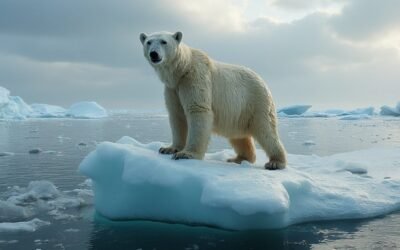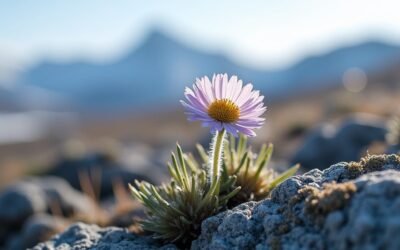How does the King Eider, a remarkable species in Arctic environments, stand out in the face of biodiversity challenges? This question invites us to explore the unique aspects of the King Eider’s life and its ecological role.
The King Eider, Somateria spectabilis, showcases distinctive reproductive and social behaviors that are not only fascinating but also critical for its survival in harsh Arctic conditions. These birds demonstrate a remarkable strategy where females independently find nesting sites, yet they come together to collectively care for their young. This blend of solitary and communal living is a testament to their adaptability. Their diet, predominantly composed of marine benthos, positions them as vital predators within their ecosystem, influencing the health and balance of marine life in the Arctic waters.
However, this species faces significant challenges, including the impacts of climate change and habitat degradation. These threats jeopardize their nesting sites and food sources, thereby complicating their survival and reproductive success. The situation of the King Eider underscores the complex interplay between species and their environment, emphasizing the necessity for dedicated conservation efforts to safeguard these birds and their habitat.
Understanding and addressing the challenges faced by the King Eider is crucial for preserving Arctic biodiversity. Their story is a compelling chapter in the broader narrative of environmental conservation, highlighting the need for ongoing research and action to protect these iconic birds and their ecosystems.
Key Takeaways
Key Takeaways:
- King Eiders possess specialized breeding behaviors, communal chick-rearing practices, and skilled marine foraging abilities that exhibit their adaptability and crucial role in Arctic ecosystems.
- The global population of King Eiders, estimated at around 800,000, signals a species experiencing significant conservation challenges.
- Targeted conservation efforts are imperative to address the threats of habitat loss, hunting, and climate change, aiming to protect King Eider populations.
The balance between the adaptability of King Eiders and the conservation challenges they face highlights the need for focused efforts to ensure their survival.
Scientific Classification
King Eider’s Taxonomic Origins
Carl Linnaeus, in 1758, recognized the distinct nature of the King Eider and classified it accordingly. Later, in 1819, William Elford Leach further refined its place in the natural world by assigning it to the genus Somateria. The specific epithet, spectabilis, reflects its striking presence and adaptability to the unforgiving Arctic climates.
Adaptations to Arctic Life
The term Somateria, meaning ‘wooly body,’ draws attention to the King Eider’s specialized adaptations. These include its remarkable plumage that insulates it against the extreme cold of its habitat, spanning from Alaska to Russia. This adaptation is vital for their survival in the broad and harsh Arctic environments where they breed and thrive.
Genetic Links and Unique Status
Despite their wide range and the potential for genetic diversity, King Eiders maintain a monotypic status, without any recognized subspecies. This uniformity is intriguing given their extensive distribution. Their close genetic ties with Common Eiders, highlighted by occasional hybridization events, emphasize both the fluidity and the distinctions within the Somateria genus. Yet, these interactions don’t blur the King Eider’s unique identity within the Arctic’s avian community.
Environmental Role and Distribution
King Eiders have a pivotal role in the ecosystems of the Arctic, with their distribution encompassing crucial breeding sites across multiple continents. This circumpolar presence underlines the species’ ecological importance and its adaptability to varying Arctic conditions, despite the absence of subspecies. Their consistent appearance across vast geographical areas underscores the species’ ecological niche and highlights their significance in Arctic biodiversity.
Habitat
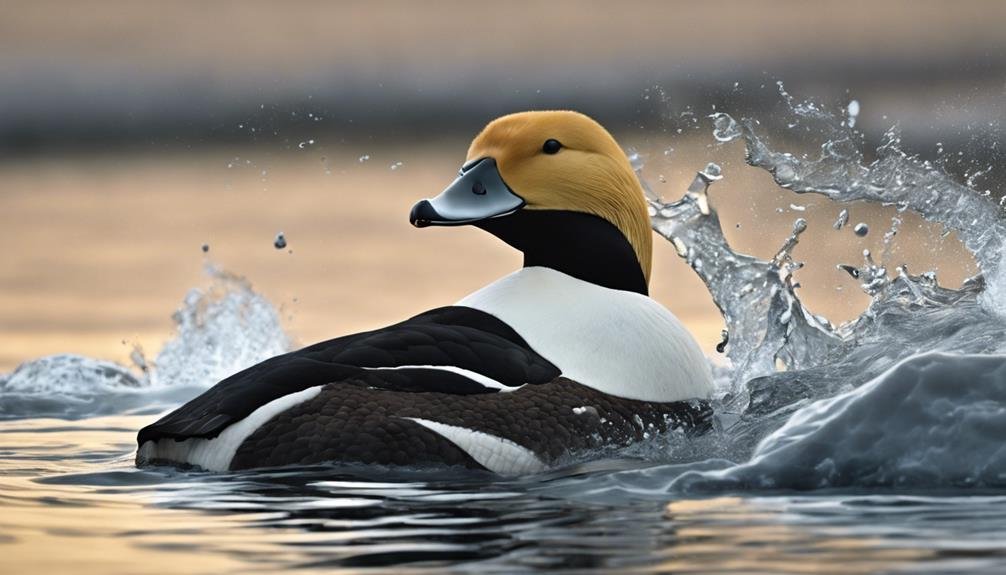
Winter Coastal Retreats
King Eiders seek refuge along the rocky coastlines during the chill of winter. These areas not only offer them shelter but also provide them with unfrozen waters vital for their foraging activities. The ruggedness of the coastline acts as a natural barrier against harsh winter conditions, making it an ideal winter habitat for these birds.
Breeding in the Arctic Expanse
When the season turns, King Eiders embark on their journey to the Arctic tundra for the breeding period. This vast, open land serves as the perfect backdrop for their nesting activities, providing ample space and minimal threat from predators. The isolation of the tundra plays a significant role in their breeding success, offering a serene environment for the next generation to hatch.
Foraging Depths of the Sea Bed
To sustain themselves, King Eiders are known to dive up to 80 feet beneath the sea’s surface to reach the sea bed. This remarkable ability enables them to access a rich variety of aquatic food sources that are unavailable to many other species. Their adept diving skills are a testament to their adaptation to the marine environment.
Spring Migration: A Spectacular Voyage
The spring migration of King Eiders is a breathtaking natural event, where massive flocks gather, navigating through varying conditions of light and visibility. This migration highlights their incredible adaptability and resilience, facing the challenges of long-distance travel with remarkable ease.
During the breeding season, female King Eiders take on the sole responsibility of nest attendance and egg incubation, showcasing their dedication and the sacrifices they make. This period of reduced feeding emphasizes the tough choices these birds face in the balance of breeding success against their own survival in the demanding Arctic habitat.
This overview of the King Eider’s habitat illustrates the deep connection between these birds and their environment, showcasing their adaptability and resilience across different seasons and conditions.
Diet
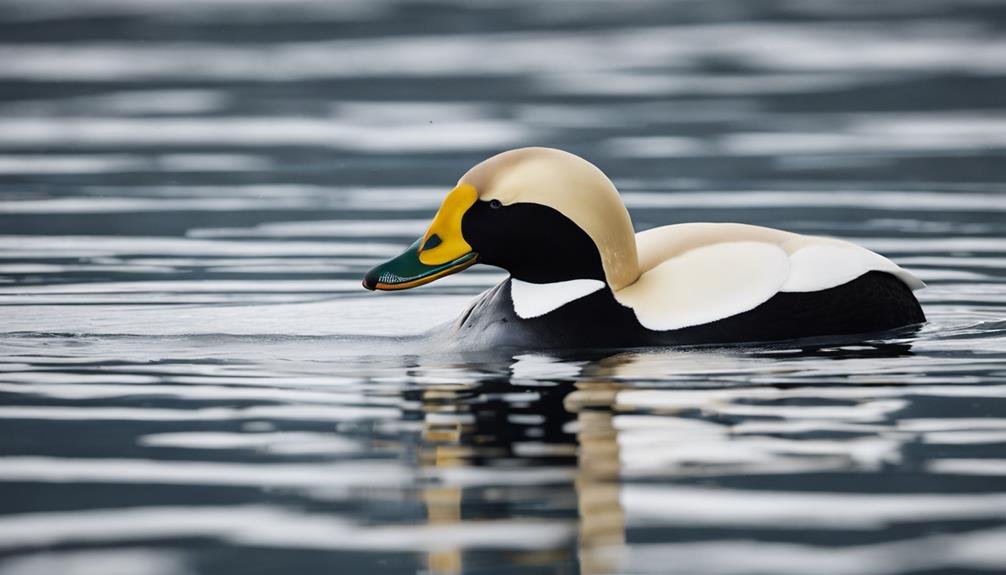
King Eiders’ Diverse Diet
King Eiders exhibit a remarkable ability to sustain themselves on a wide variety of food sources. Their diet encompasses shellfish, crustaceans, algae, insects, and plants, showcasing their adaptability to different marine environments. These birds are skilled divers, plunging to depths of up to 180 feet to seek out their meals. This proficiency in foraging sets them apart, enabling access to a plethora of invertebrate and marine life that remains elusive to other avian species.
Nutritional Adaptations Across Seasons
The dietary landscape of King Eiders changes with the seasons, reflecting their nutritional strategies for survival and reproduction. Shellfish, available year-round, serve as a steady protein source. The nesting season sees an increase in crustaceans consumption, providing essential amino acids critical for the health of developing chicks. Additionally, algae and plants offer vitamins and dietary fiber, varying in availability and contributing to the dietary diversity necessary for their energetic lifestyle.
Ecological Impact of Dietary Choices
King Eiders’ preference for shellfish and echinoderms plays a significant role in their diet, particularly emphasizing the birds’ reliance on these marine resources for sustenance. The inclusion of crustaceans and insects during the nesting period is vital, ensuring that both adults and offspring receive the nutrients needed for vitality. This varied diet not only supports King Eiders’ survival in their challenging habitats but also underscores their critical role in the marine food webs. Their feeding habits reflect the intricate balance within marine ecosystems, highlighting the importance of King Eiders in maintaining ecological harmony.
Behaviour
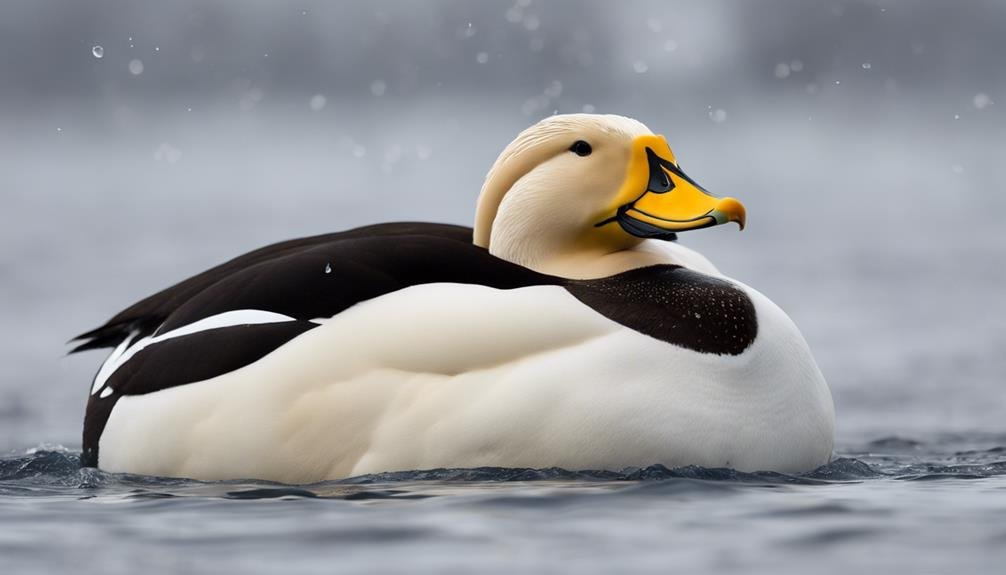
Diving into the Fascinating World of King Eider Behavior
King Eiders aren’t just birds; they’re marvels of nature that demonstrate incredible adaptability and social behaviors in their natural habitats. From their foraging habits to the way they care for their young, these birds exhibit a complex set of behaviors that ensure their survival in harsh environments.
Adaptive Foraging Strategies
One of the most striking aspects of King Eider behavior is their ability to adapt their foraging strategies according to the environment. During the breeding season, these birds switch to freshwater habitats where they search for small invertebrates. This shift from the challenging sea bed foraging, where they dive up to 80 feet to find food, to a more manageable freshwater environment highlights their flexibility in food sourcing. This behavior not only showcases their resilience but also their resourcefulness in ensuring a steady food supply.
Social Dynamics and Migration
King Eiders are known for their impressive social behavior, especially during migration. They form massive flocks, sometimes numbering up to 100,000 individuals, to migrate. This collective movement strategy not only provides safety in numbers but also demonstrates their highly social nature. The formation of such large groups during migration is a testament to their ability to coordinate and collaborate, ensuring successful and safe travel over long distances.
Communal Care-Giving
Another remarkable behavior is their communal approach to chick rearing. After hatching, female King Eiders come together to rear the chicks in a protective environment. This communal care-giving strategy fosters a supportive surrounding for the young birds, safeguarding them until they’re ready to fledge at about 50 days old. This behavior underlines the importance of social bonds and collective effort in the survival of their offspring.
Remarkable Diving Ability
The King Eider’s diving capability is a testament to their physical prowess. Their ability to plunge up to 80 feet deep in search of food on the sea bed isn’t just a display of their physical capability but also of their determination and adaptability. This skill allows them to exploit food sources that are unavailable to many other species, giving them an edge in the survival game.
In examining the behavior of King Eiders, we uncover a complex interplay of adaptability, social cooperation, and dedicated parenting. These behaviors aren’t just strategies for survival; they’re a testament to the remarkable resilience and resourcefulness of these birds.
Conservation
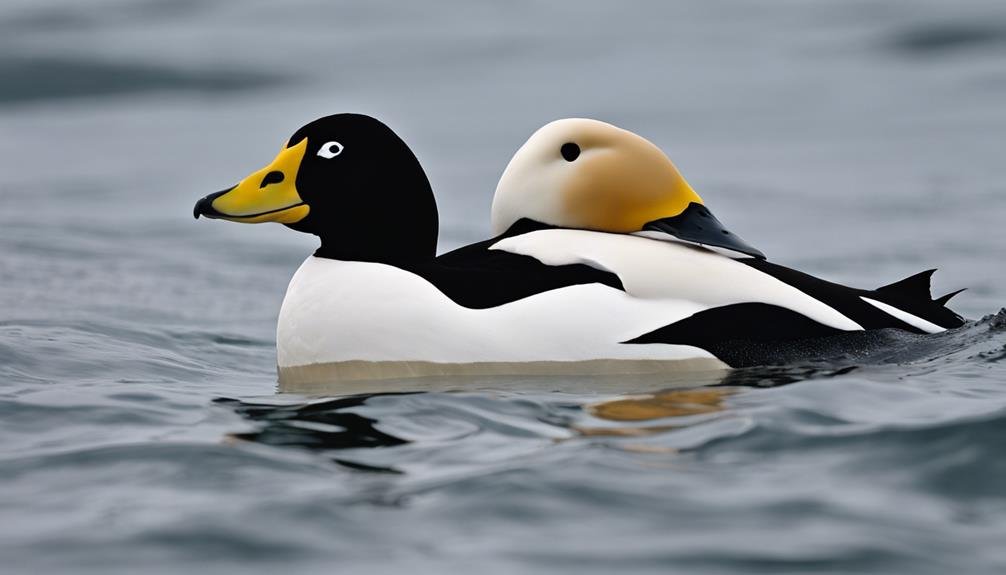
Conservation Status and Global Efforts
Despite being classified as of least concern, the King Eider population requires vigilant conservation due to environmental and human-induced challenges. The IUCN acknowledges their stable numbers, with an estimated population between 790,000 and 930,000 individuals. They’re protected under the Agreement on the Conservation of African-Eurasian Migratory Waterbirds, highlighting the international commitment to preserving their habitats.
Natural Predators and Population Dynamics
King Eiders face significant threats from natural predators like the Glaucous Gull and Arctic Fox, especially during the breeding season. These predators can influence the birds’ population dynamics, emphasizing the need for monitoring and protective measures during vulnerable periods.
Cultural Importance and Sustainable Harvesting
The cultural significance of King Eiders to indigenous communities, especially the Yupik people, can’t be overstated. These communities depend on the birds as a crucial source of fresh meat. Historically, hunting practices during migration in the Yukon-Kuskokwim Delta have been significant, highlighting the need for sustainable harvesting practices to prevent overexploitation.
Balancing Ecological and Cultural Needs
Efforts to conserve the King Eider population must carefully balance ecological preservation with the traditional practices of indigenous communities. Implementing sustainable hunting regulations and protecting key habitats are vital steps toward supporting the birds’ long-term survival while respecting cultural traditions.
Climate Change Impacts
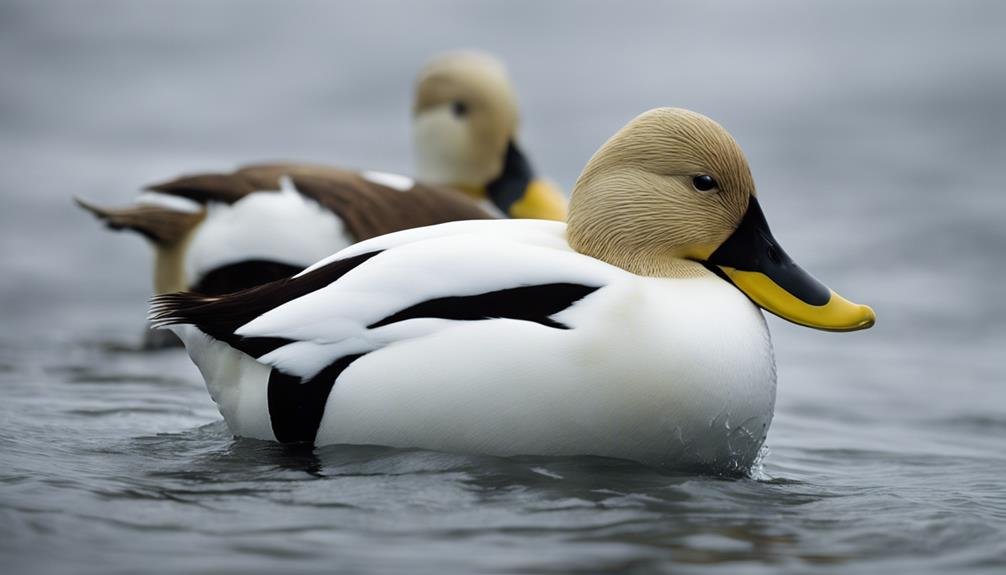
As we delve into the challenges posed by climate change to the Arctic habitats, it’s essential to focus on specific aspects that threaten the survival of King Eiders. Their existence is finely tuned to the delicate ecological balance of the Arctic, and as such, they serve as indicators of broader environmental shifts.
Habitat Degradation
One significant impact of a warming climate is the degradation of the Arctic environment, which plays a crucial role in the life cycle of King Eiders. The melting ice and permafrost, coupled with rising temperatures, directly affect the birds’ nesting and breeding grounds, making it increasingly difficult for them to find suitable areas for raising their young.
Shifts in Prey Dynamics
The availability of food is another critical factor influenced by changing sea ice patterns and the timing of ice melts. These shifts lead to variations in the distribution and abundance of aquatic prey species, which are vital for King Eiders during foraging. As their primary food sources become harder to find, these birds face challenges in meeting their nutritional needs, which can affect their reproductive success and survival rates.
Migration Challenges
Changes in the Arctic climate also disrupt the traditional migration routes of King Eiders. The loss of ice cover and alterations in coastal areas due to warming temperatures and rising sea levels create navigational challenges for these birds. Such disruptions can lead to increased energy expenditure during migration, reducing their overall fitness and ability to reproduce.
Increased Risks from Predators and Rivals
As prey species move and adapt to the changing environment, King Eiders may encounter new or increased competition for food, as well as heightened predation risks. These additional pressures compound the survival threats posed by habitat loss and reduced food availability, underscoring the need for comprehensive conservation strategies.
Understanding the interconnectedness of these factors highlights the urgency of addressing climate change to protect the Arctic breeding grounds and ensure the future of King Eiders. Conservation efforts must consider the complex interplay of habitat quality, food dynamics, migration patterns, and ecological competition to effectively support these birds in their natural environment.
Other Interesting Facts
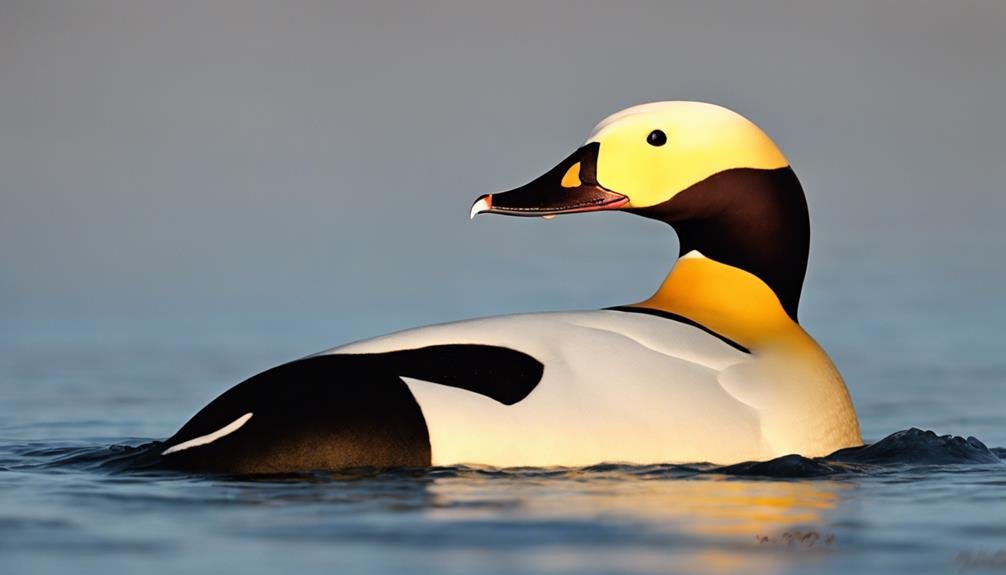
Genetic Diversity and Adaptation
King Eiders are remarkable for their genetic diversity, which is vividly illustrated by their ability to cross-breed with Common Eiders. This phenomenon exemplifies the fluid nature of avian genetics, showcasing the resilience and adaptability of these birds. The genus Somateria, translating to ‘wooly body,’ is a nod to their unique adaptation. Their down feathers, providing unparalleled insulation, are a testament to their evolutionary success in cold habitats.
Distinctive Physical Traits
The species name spectabilis, meaning remarkable, perfectly encapsulates the King Eider’s distinguished presence among waterfowl. Their striking appearance, combined with the wooly body hinted at by their genus name, sets them apart in the avian world. The weight variation of these birds, ranging from 0.9 kg to 2.2 kg, reflects their adaptive strategies for managing energy reserves. This variation plays a significant role in maintaining optimal body temperature, crucial for survival in extreme cold conditions.
Stable Genetic Identity Across Ranges
Despite their widespread distribution, King Eiders don’t have recognized subspecies. This fact underscores their stable genetic identity over vast geographic expanses. Their consistent physical and genetic traits across different regions highlight the species’ adaptability and resilience, ensuring their survival in diverse and challenging environments.
What Are the Similarities and Differences Between King Eiders and Narwhals?
King eiders and narwhals are both Arctic species with unique characteristics. While king eiders are sea ducks known for their striking plumage, narwhals are known for their narwhal’s unique characteristics – the long, spiraled tusk that males have. Both animals are adapted to life in cold, icy waters but have very different physical features.
Frequently Asked Questions
What Are Some Interesting Facts About King Eiders?
How Fast Can King Eiders Fly?
King Eiders are known for their impressive flight speed, capable of reaching speeds over 70 km/h. This aspect of their migration showcases their agility and stamina in the wild.
What Are the Breeding Habits of King Eiders?
King Eiders exhibit unique breeding habits by nesting in Arctic tundras. They are distinctive for their colorful plumage during the breeding season, which aids in attracting mates and signaling readiness for reproduction.
What Makes the Vocal Sounds of King Eiders Unique?
The vocal sounds of King Eiders are notable for their uniqueness. Each bird produces distinct sounds that can vary from soft cooing to more complex calls, serving as a means of communication among individuals and signaling during mating seasons.
What Is the Conservation Status of King Eiders?
Despite having a stable population, King Eiders are under continuous observation for conservation. Their habitats and breeding grounds need protection to ensure the species remains out of danger.
How Far Can a King Eider Dive?
How Deep Can a King Eider Dive?
Question: What is the maximum depth a King Eider can dive to?
Answer: A King Eider can dive to depths exceeding 50 meters. This ability is supported by their specialized adaptations for managing oxygen, handling water pressure, and regulating body temperature during dives.
What Do King Eiders Eat?
What do King Eiders eat?
King Eiders primarily consume a diet consisting of aquatic invertebrates, crustaceans, and mollusks. They adjust their feeding locations and behaviors based on the season, often diving deep to find food during daylight hours. This species shows a preference for feeding in the daytime and selects specific types of nutrients found within their prey.
How Big Is a King Eider?
Q: What is the size of a King Eider?
A: Male King Eiders can reach up to 70cm in length, while females are generally smaller. This size difference is part of their adaptations to their environment and breeding behaviors.
Conclusion
In facing the combined threats of habitat loss, hunting, and climate change, King Eiders have demonstrated remarkable resilience through their specialized breeding behaviors, communal chick-rearing practices, and proficient diving skills for marine foraging. These strategies not only underscore their adaptability but also their vital role in Arctic ecosystems.
Despite these strengths, the global population, standing at around 800,000, indicates a species under considerable conservation pressure. The evidence points towards the urgent need for targeted efforts to alleviate these pressures, aiming to safeguard the future of King Eider populations across their circumpolar range.
This synthesis of their situation highlights the balance between their innate adaptability and the ongoing conservation challenges they face, underscoring the importance of sustained, focused conservation actions.

